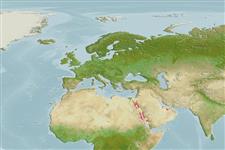Classification / Names
Common names | Synonyms | Catalog of Fishes (gen., sp.) | ITIS | CoL | WoRMS | Cloffa
Actinopterygii (ray-finned fishes) >
Atheriniformes (Silversides) >
Atherinidae (Silversides) > Atherinomorinae
Etymology: Atherinomorus: Greek, atherina, the Greek name for the eperlane + Greek, moros = silly, stupid (Ref. 45335).
Environment / Climate / Range
Ecology
Marine; reef-associated. Tropical, preferred ?
Western Indian Ocean: endemic to the Red Sea and has invaded the eastern Mediterranean through the Suez Canal.
Size / Weight / Age
Maturity: Lm ? range ? - ? cm
Max length : 13.3 cm SL male/unsexed; (Ref. 58474)
Short description
Morphology | Morphometrics
Dorsal
spines
(total): 5 - 7;
Dorsal
soft rays
(total): 8-10;
Anal
spines: 1;
Anal
soft rays: 11 - 15;
Vertebrae: 40 - 44. This species is distinguished by the following set of characters: lateral process of premaxilla very low and wide; upper margin of dentary almost flat distally, no distinct tubercle at the posterior end; posterior tip of the upper jaw reaching to or exceeding a vertical through anterior margin of the pupil, and not reaching to a vertical through center of the pupil; teeth on endopterygoids large, forming distinct ridges; anus located around posterior tip of the pelvic fin; lower gill rakers 20-23; midlateral scale count 39-43; lower margin of midlateral band reaching to or just below ventral end of the midlateral (third) scale row at the level of the anal fin origin (Ref. 58474).
Feeds on zooplankton, small bottom-living invertebrates (Ref. 5980).
Life cycle and mating behavior
Maturity | Reproduction | Spawning | Eggs | Fecundity | Larvae
Kimura, S., D. Golani, Y. Iwatsuki, M. Tabuchi and T. Yoshino, 2007. Redescriptions of the Indo-Pacific atherinid fishes Atherinomorus forskalii, Atherinomorus lacunosus, and Atherinomorus pinguis. Ichthyol. Res. 54(2):145-159. (Ref. 58474)
IUCN Red List Status (Ref. 115185)
CITES (Ref. 94142)
Not Evaluated
Threat to humans
Harmless
Human uses
More information
Common namesSynonymsMetabolismPredatorsEcotoxicologyReproductionMaturitySpawningFecundityEggsEgg development
Age/SizeGrowthLength-weightLength-lengthLength-frequenciesMorphometricsMorphologyLarvaeLarval dynamicsRecruitmentAbundance
ReferencesAquacultureAquaculture profileStrainsGeneticsAllele frequenciesHeritabilityDiseasesProcessingMass conversion
Tools
Special reports
Download XML
Internet sources
